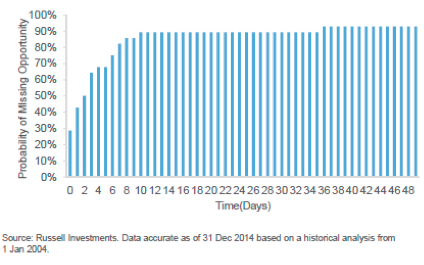Derisking: Timing is everything
From the blog: It is not just stand-up comedians that know how important timing is to success. For pension professionals and investors, the ability to implement a decision in a timely fashion can be critical to success.
There are many examples over recent years where the market has presented opportunities for pension funds to reduce risk and lock in funding level improvements. But these opportunities have been fleeting.
Timing is key when it comes to risk reduction.
A common feature of many pension fund investment strategies is a trigger framework that involves reducing exposure to risky, return-seeking assets based on the relative performance of different asset classes, time, or funding level.
Pulling the trigger
We’ve analysed the length of time that an opportunity remains open based on a funding level trigger.
Quite simply this can be thought of as the time a scheme has to take action before the funding level once again falls below the trigger level.
For example, a pension scheme could aim to reduce risk following a breach of a funding level trigger at 80 per cent on a Monday, only for markets to move significantly by Friday, causing their funding level to drift to 78 per cent and well back below the trigger.
Unsurprisingly, the time that an opportunity takes to revert is relatively short. You can see this looking back at the historical returns and funding levels based on the asset allocation for a typical UK pension scheme.
In as many as 60 per cent of cases where a trigger was breached, opportunities were lost in as little as four working days.
In as little as two days, the probability of missing an opportunity is around 50 per cent. Two days is an incredibly short time in the world of investment committee meetings, international investments and manager notification deadlines.
Probability of losing the derisking benefit as time passes…
Furthermore, many pension professionals use return and funding ratio data that is often days (if not weeks) delayed, meaning there is the added risk that derisking decisions are made without current information.
Considering how short-lived risk reduction opportunities are, it’s imperative that decisions can be acted on quickly.
A method to monitor funding levels on a daily basis is critical and, ultimately, an effective solution that can capitalise on these small windows of opportunities requires flexibility.
No matter how good the material, a joke can fall flat if it is not delivered with impeccable timing. Likewise an investment and risk management process can fall apart if the mechanism to implement decisions is missing.
David Rae is head of client strategy and research EMEA at Russell Investments
Most Viewed
- ‘A fundamental point of fairness’: MPs call for action on discretionary increases
- TPR to scrutinise ‘systemically important’ professional trustee firms
- What does Labour have in store for the pensions industry?
- Defining the role of the scheme actuary
- Five themes at the forefront of a sustainable future


